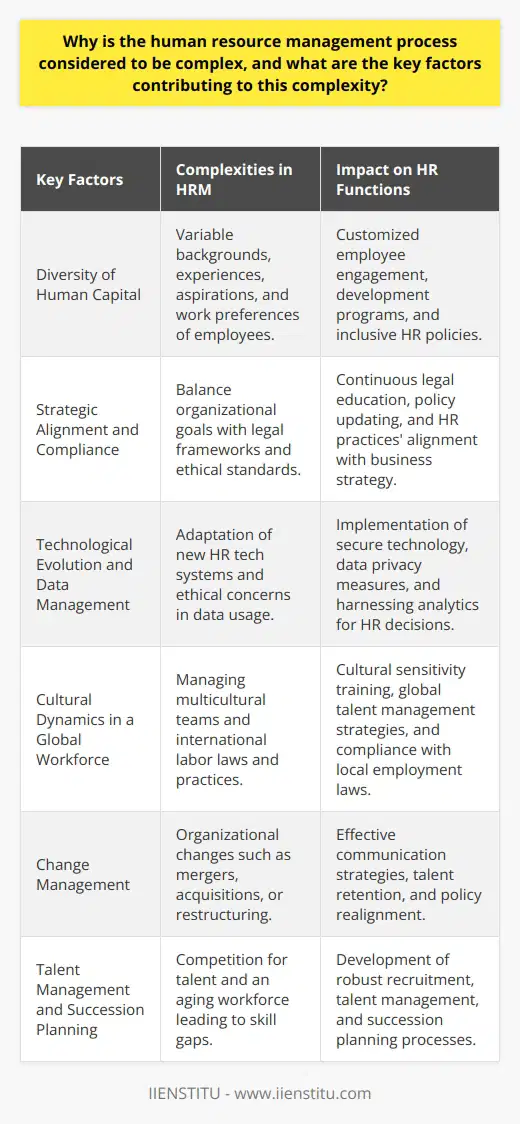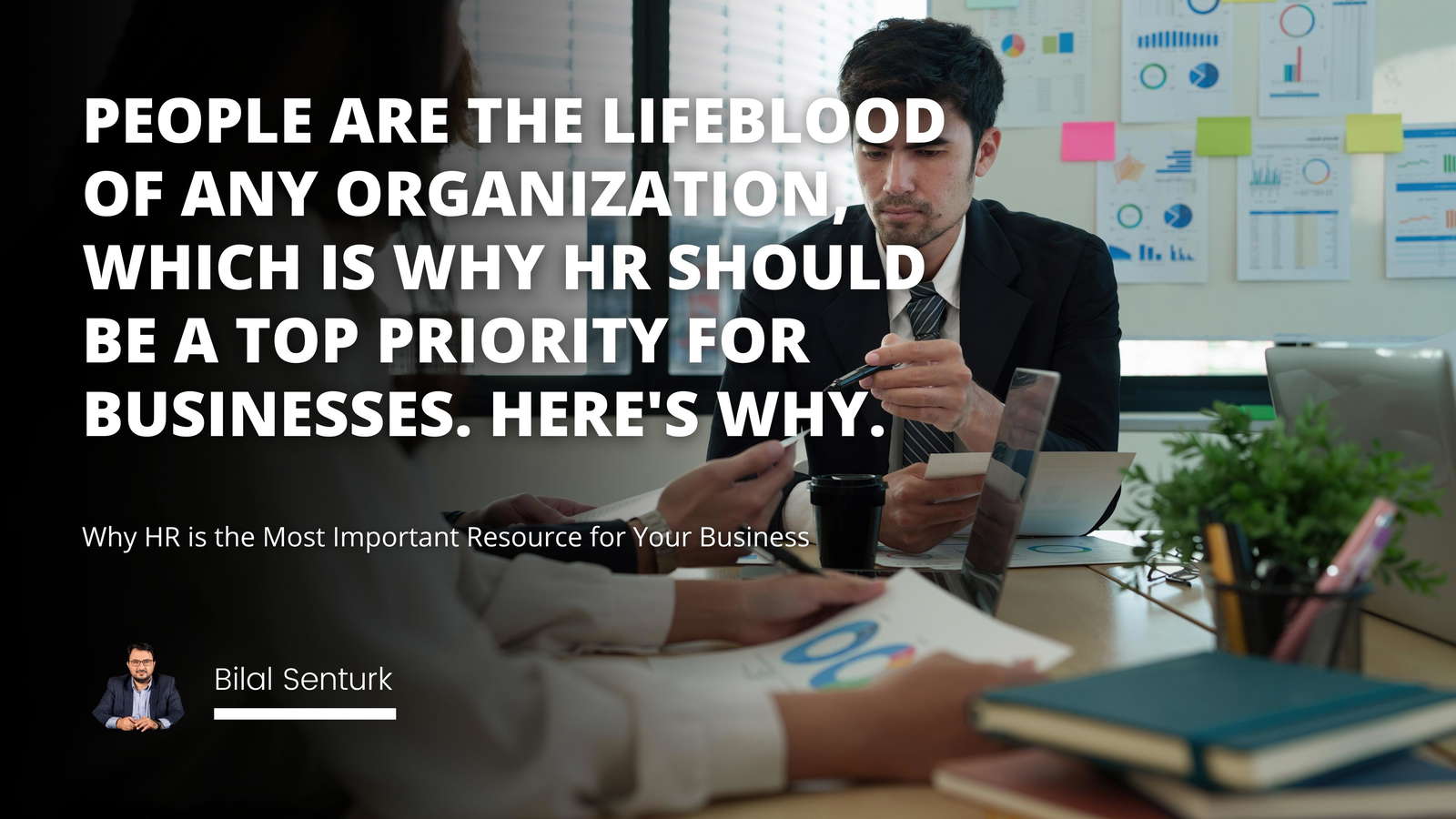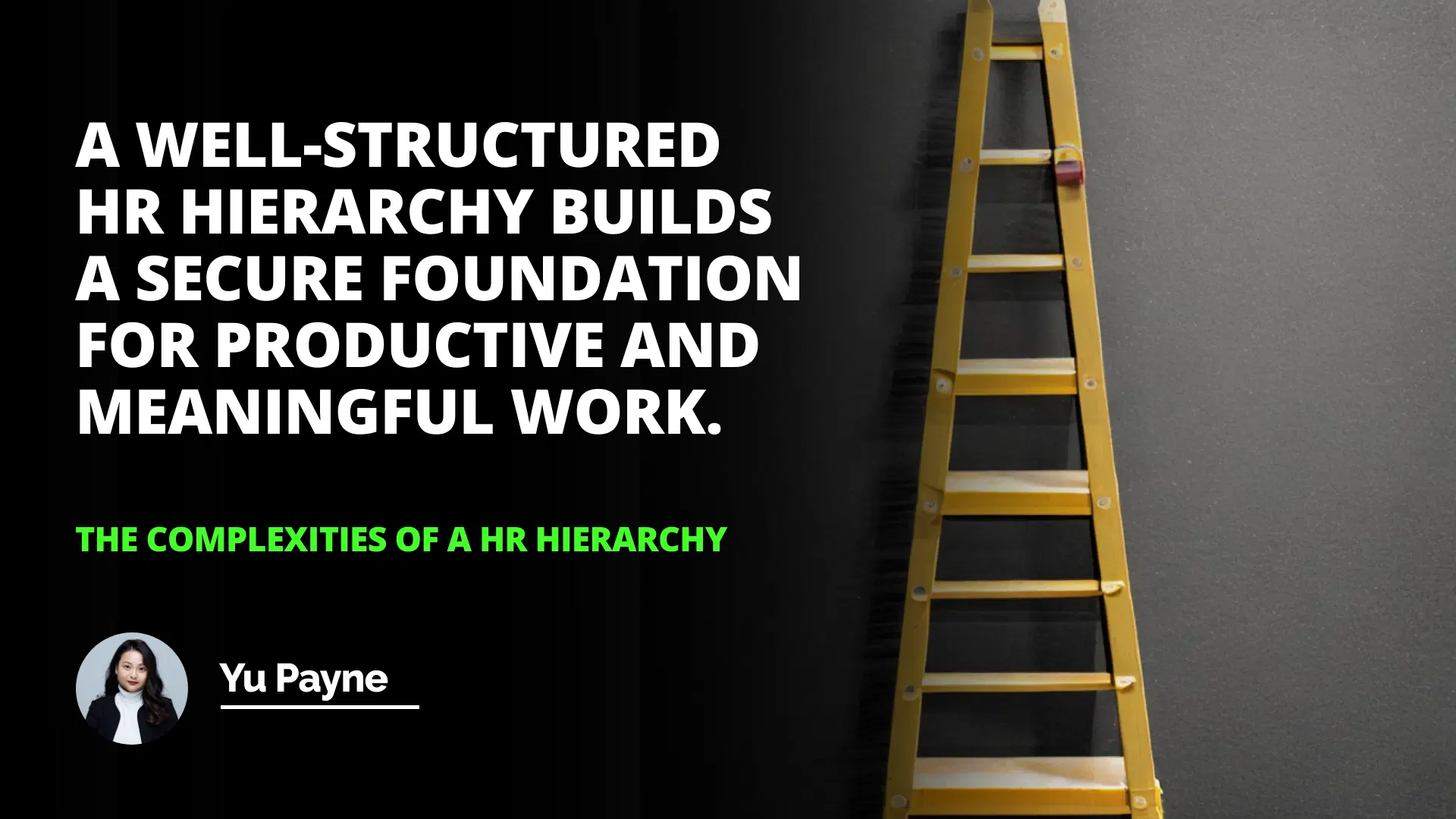
Understanding HR Hierarchies: Finding the Right Fit for Your Organization
Types of HR Hierarchies
Advantages and Disadvantages of Each Hierarchy
Practical Examples
I'll never forget my first day as an HR intern at a midsize manufacturing company. Walking into the bustling office, I was overwhelmed by the sheer complexity of the HR department. There were so many layers, so many people to report to—it felt like navigating a maze. Over time, I realized that the structure of an HR department can significantly impact not just the efficiency of the team, but the entire organization.
The Importance of HR Hierarchies
In any organization, the Human Resources department is the backbone that supports employee well-being, compliance, and organizational culture. Choosing the right HR hierarchy is akin to laying a strong foundation for a building—it affects everything constructed upon it. But how do you decide which hierarchy suits your organization best?
Traditional Hierarchy
Think of the traditional hierarchy as the classic family tree. At the top sits the HR Manager or Director, followed by mid-level managers, and then the HR staff. This top-down approach is straightforward and easy to understand, making it a popular choice for many companies.
Advantages:
Clear Lines of Authority: Everyone knows who they report to, reducing confusion.
Efficient Decision-Making: Decisions can be made quickly since approval comes from the top.
Accountability: It's easy to hold individuals accountable due to defined roles.
Disadvantages:
Rigidity: This structure can be inflexible, making it hard to adapt to change.
The Core of HR: Legal, Hiring, Comp, Perf, Benefits, ER, Training, HRIS
Adaptability in Human Resources Management: What Does it Mean?
Communication Gaps: Information may not flow freely between levels.
Employee Dissatisfaction: Lower-level employees might feel their voices aren't heard.
In my experience working with a traditional hierarchy, I noticed that while processes were efficient, there was often a disconnect between management and staff. Suggestions from the frontline employees rarely made it up the chain.
Matrix Hierarchy
The matrix hierarchy is like a web where employees report to multiple managers for different projects. It's a blend of departmental and project-based structures, promoting collaboration across departments.
Advantages:
Enhanced Collaboration: Encourages teamwork across different departments.
Flexibility: Can adapt quickly to new projects or changes.
Resource Efficiency: Maximizes the use of skills and talents within the organization.
Disadvantages:
Complex Reporting: Employees may be confused about whom to report to.
Conflict of Interest: Competing priorities between managers can cause tension.
High Demand on Employees: Requires a high level of organization and communication skills.
Perfect Compensation And Benefits Package For Attracting And Retaining Top Talent
How To Develop Critical Human Resources Skills For Successful Hr Career
When I transitioned to a tech startup that used a matrix structure, I appreciated the collaborative environment. However, juggling directives from multiple managers was often challenging.
Complex Hierarchy
A complex hierarchy is a dynamic and fluid structure designed for organizations that need to adapt constantly. It's less about ranks and more about roles, often seen in creative industries or research institutions.
Advantages:
Adaptability: Easily adjusts to new challenges and projects.
Innovation Encouragement: Fosters an environment where new ideas are valued.
Employee Empowerment: Employees often have more autonomy.
Disadvantages:
Lack of Clarity: Roles and responsibilities may be unclear.
Potential for Chaos: Without strong leadership, things can become disorganized.
Communication Issues: Information might not reach all team members effectively.
At an advertising agency I consulted for, the complex hierarchy allowed for amazing creativity. But sometimes, projects suffered due to a lack of clear direction.
Hybrid Hierarchy
The hybrid hierarchy combines elements from the traditional, matrix, and complex structures. It's customized to fit an organization's specific needs, balancing stability with flexibility.
Advantages:
Customization: Can tailor the structure to the organization's culture and goals.
Balanced Approach: Offers clarity while promoting collaboration.
Scalability: Adapts well as the company grows or changes direction.
Disadvantages:
Implementation Challenges: Can be difficult to design effectively.
Possible Confusion: Employees might be uncertain about structure changes.
Resource Intensive: Requires careful management and possibly more resources.
One of my most rewarding projects was helping a nonprofit develop a hybrid hierarchy. It struck the perfect balance between structure and flexibility, allowing them to expand their programs efficiently.
Practical Examples of HR Hierarchies in Action
Traditional Hierarchy at Netflix
Netflix employs a traditional hierarchical structure within its HR department. Each section has specific responsibilities, and there's a clear chain of command. This structure supports Netflix's focus on efficiency and accountability.
A well-structured HR hierarchy builds a secure foundation for productive and meaningful work.
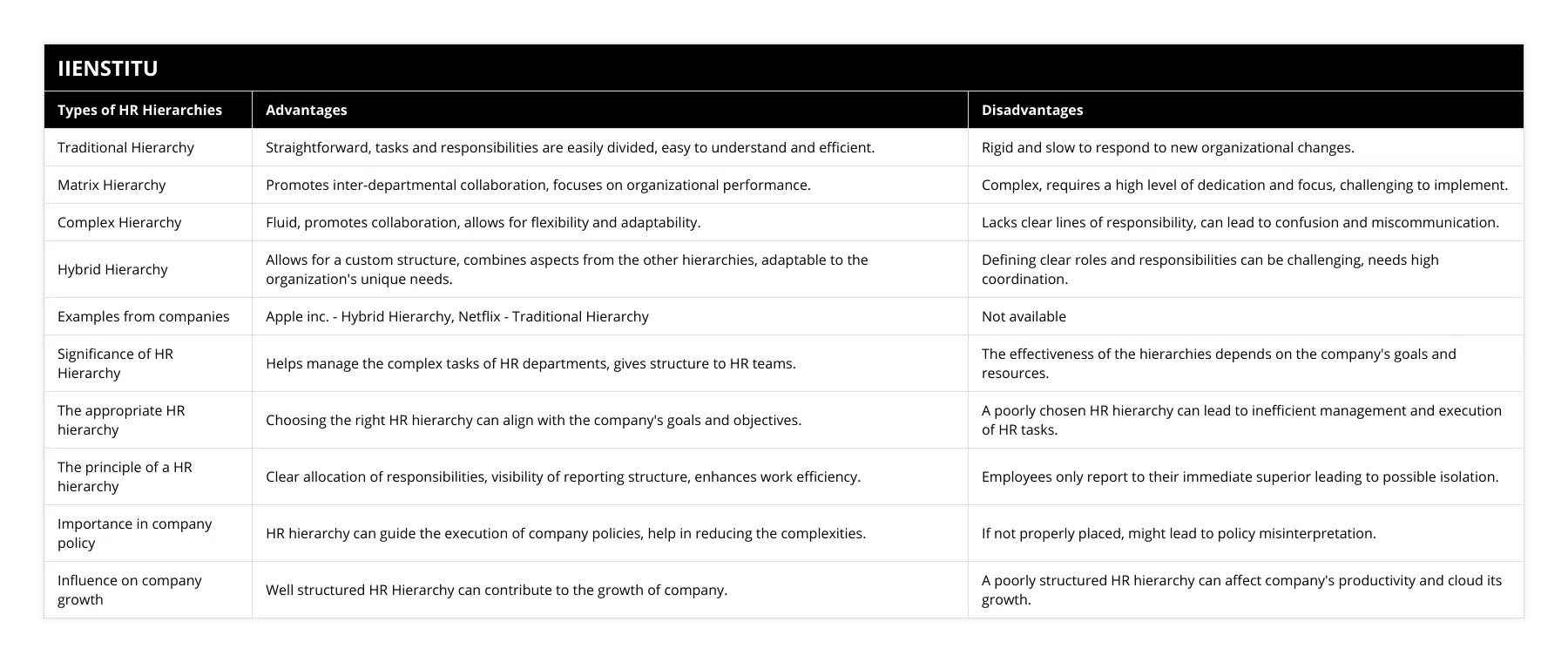
By using a traditional hierarchy, Netflix ensures that decisions are made swiftly, which is crucial in the fast-paced entertainment industry.
Matrix Structure at Procter & Gamble
Procter & Gamble (P&G) utilizes a matrix hierarchy, encouraging collaboration across different product lines and regions. Employees at P&G often work on multiple teams, reporting to both a functional manager and a project manager.
This approach allows P&G to innovate and adapt products to various markets efficiently, staying ahead in the competitive consumer goods sector.
Complex Hierarchy at Google
Google is known for its complex hierarchy that promotes innovation. Employees are encouraged to spend time on projects they're passionate about, leading to groundbreaking products like Gmail and Google Maps.
The fluid structure at Google fosters an environment where creativity thrives, though it requires employees to be self-motivated and communicative.
Hybrid Hierarchy at Apple Inc.
Apple combines different hierarchical elements to suit its unique needs. With executive leadership, support staff, and regional operations, Apple's hybrid hierarchy allows for both centralized control and regional adaptability.
This structure supports Apple's commitment to consistency in brand and quality, while also allowing for regional market considerations.
Making the Right Choice for Your Organization
Selecting the appropriate HR hierarchy isn't just about efficiency—it's about aligning with your organization's values, goals, and industry demands. Here are some tips to help you decide:
1- Assess Your Organizational Culture: Is your company more traditional or innovative?
2- Consider Your Industry: Different industries may benefit from different structures.
3- Evaluate Your Resources: Do you have the capacity to manage a complex or hybrid structure?
4- Involve Your Team: Get input from employees at all levels.
5- Plan for the Future: Choose a structure that supports your long-term goals.
Remember, there's no one-size-fits-all solution. It's about finding what works best for your unique situation.
The Connection Between HR Hierarchies and Supply Chain Management
It's interesting to note that the principles of selecting an HR hierarchy are not so different from those used to optimize supply chain management process tips. Both require careful planning, clear communication, and alignment with organizational goals.
Just as a well-structured HR hierarchy builds a secure foundation for productive work, an optimized supply chain ensures that products reach customers efficiently and reliably.
Conclusion
Choosing the right HR hierarchy is a critical decision that can influence every aspect of your organization. Whether you opt for a traditional, matrix, complex, or hybrid structure, it's essential to understand the advantages and disadvantages of each.
Reflecting on my own experiences across various companies, I've seen firsthand how the right hierarchy can empower employees, streamline processes, and drive success. It's about creating an environment where everyone knows their role but also feels valued and heard.
So, take the time to evaluate your organization's needs, involve your team in the decision-making process, and don't be afraid to customize a structure that fits your unique goals. After all, the strength of your HR department can be the key to unlocking your organization's full potential.
References
1- Armstrong, M. (2012). Armstrong's Handbook of Human Resource Management Practice. Kogan Page Publishers.
2- Daft, R. L. (2015). Organization Theory and Design. Cengage Learning.
3- Jones, G. R. (2013). Organizational Theory, Design, and Change. Pearson Education.
4- Mintzberg, H. (1983). Structure in Fives: Designing Effective Organizations. Prentice-Hall.
5- Robbins, S. P., & Judge, T. A. (2016). Organizational Behavior. Pearson.
6- Schein, E. H. (2010). Organizational Culture and Leadership. John Wiley & Sons.
Frequently Asked Questions
How does the complexity of a HR hierarchy affect organizational structure?
The complexity of an HR hierarchy can have a significant impact on the structure of an organization. In particular, the more complex the HR hierarchy, the more challenging managing and assessing organizational performance can be. A complex HR hierarchy can lead to a lack of clarity in roles and responsibilities, and this can result in employees feeling frustrated and unclear on the expectations of their position; additionally, it can make the communication of policy and procedures difficult by making it difficult to reach the right people to communicate changes or roll-outs effectively.
Due to the complexity of a complex HR hierarchy, the organizational structure of an organization can become difficult to maneuver and manage. When an HR hierarchy is overly complicated, resources can be channeled inefficiently and lead to stagnation or inefficiencies due to a lack of an understanding of roles, authority, and tasks. This can harm a company's performance since organizational tasks may not be completed promptly or may be missed altogether.
Additionally, a complex HR hierarchy can lead to a lack of flexibility in decision-making. Employees may be unable to make decisions independently and may have to resort to long-winded processes to get the answers they need or make decisions. This can lead to a stifling of employee creativity and innovation within an organization, as employees may be unable to think outside the box or freely express their ideas.
Overall, the complexity of an HR hierarchy can significantly affect an organization's structure. For example, a more complex HR hierarchy can decrease efficiency, decision-making power, flexibility, creativity, and innovation. Therefore, organizations need to recognize the impact of a complex HR hierarchy on their organizational structure and take steps to ensure the system is aligned with their stated goals.
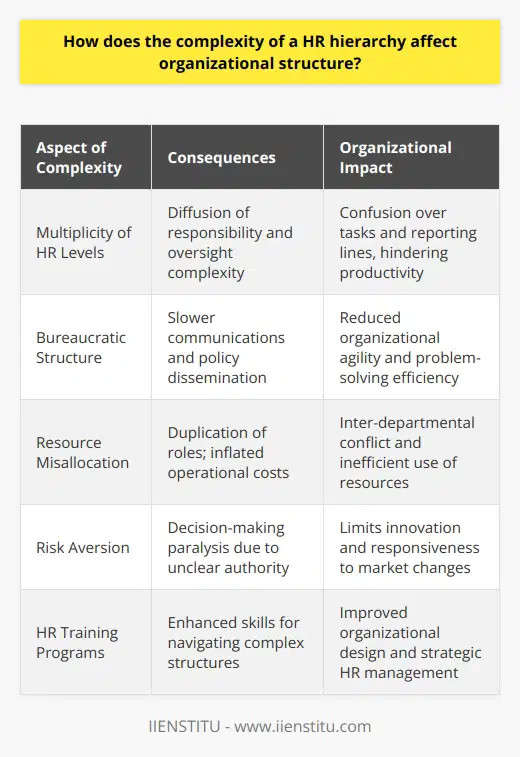
What are the advantages and disadvantages of having a complex HR hierarchy?
Human Resources (HR) hierarchy can be complex and multiple levels within a company to have an organized system of managing personnel. Still, there are both advantages and disadvantages to having such a system.
One advantage of having a complex HR hierarchy is that it can enable better decision-making control. This is because it ensures that policy changes or personnel decisions must go through different levels of approval, rather than authorities having significant authority in the organization, and a single person can make decisions. Many companies, for example, may have HR and payroll policies reviewed by executives before implementation. This level of control can ensure that measures taken by the organization are understood and accepted by stakeholders and can prevent abrupt changes in the workplace.
In addition, a complex HR hierarchy can also provide a platform for more transparency in communication and greater efficiency in decision-making. Having several levels of personnel within a company can minimize confusion and disagreement throughout various stages of the process. This ensures that all information is delivered appropriately and that decisions are not rushed.
However, having a complex HR hierarchy also has a few disadvantages. One major drawback is that this organizational structure can lead to a lack of accountability. The more extended HR hierarchy means that responsibility is spread among several people, leading to confusion and inaction when decisions need to be made or issues addressed. Additionally, bureaucracies can be created, leading to slow decision-making and administrative inefficiencies. This can cause a decrease in productivity, as well as an overall decrease in morale.
Overall, having a complex HR hierarchy can have both advantages and disadvantages. Therefore, organizations must determine the best hierarchy for their personnel management system to ensure maximum efficiency and transparency.
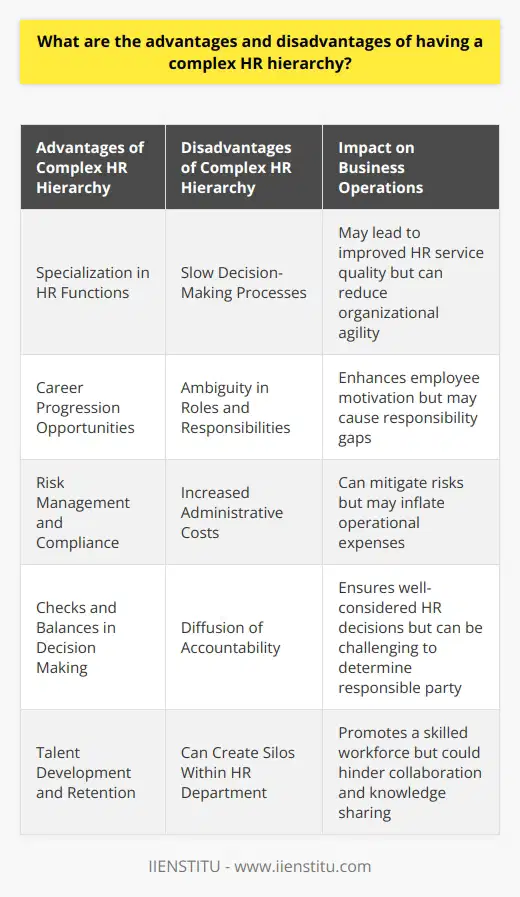
How can a complex HR hierarchy be a useful tool for managing employees?
The modern workforce is increasingly multifaceted and dispersed, making it difficult for Human Resources (HR) departments to manage employees appropriately. To successfully handle the complexities and needs of employees, HR departments often implement a hierarchical structure that can be both a helpful tool and a source of frustration. This article will explore the advantages of complex HR hierarchies and discuss how to use them best to effectively manage employee relationships.
A complex HR hierarchy can be advantageous because it offers an organized method for managing the workflow of HR tasks. In addition, by establishing tiers of supervision and authority within the department, HR personnel specializing in specific areas are accessible and able to provide more focused and tailored services. For example, an HR department may have three levels of personnel: a top-level Chief HR Officer, a second-tier managing supervisor, and a third-tier assistant supervisor. With such organized layers, HR teams are better equipped to cope with the various HR needs of employees while, at the same time, still encouraged to utilize the individual roles and expertise present within the department.
Aside from the operational benefits of a complex HR hierarchy, it also allows HR personnel to be held accountable for their performance. With multiple tiers of supervision, HR personnel are responsible to their peers and have superiors to turn to for guidance and support. This helps to create a more effective working environment in which all HR personnel remains mindful of their responsibilities and more "on-task" with their commitments.
However, complex hierarchies can also be a source of frustration, particularly regarding communication. If a simple communication gap exists between employees and their HR supervisors, it can slow down processes and, most importantly, create a hostile atmosphere in the workplace. To ensure the effectiveness and optimal productivity of the HR hierarchy, all personnel must work together to understand the employees' unique needs. The bottom-level HR personnel must address their questions and concerns to their direct supervisor so the communication chain is fluid and all issues are handled promptly and satisfactorily.
In conclusion, complex HR hierarchies can be a helpful tool for managing employees, but they must be constructed and managed carefully to ensure maximum effectiveness. While such hierarchies can empower HR personnel, promote operational efficiency and create a sense of accountability for all involved, they can also impede communication and create misunderstandings. It is, therefore, important for organizations to develop an HR hierarchy that is best suited for their specific needs and resources and for all involved to stay mindful of the responsibilities their position entails.
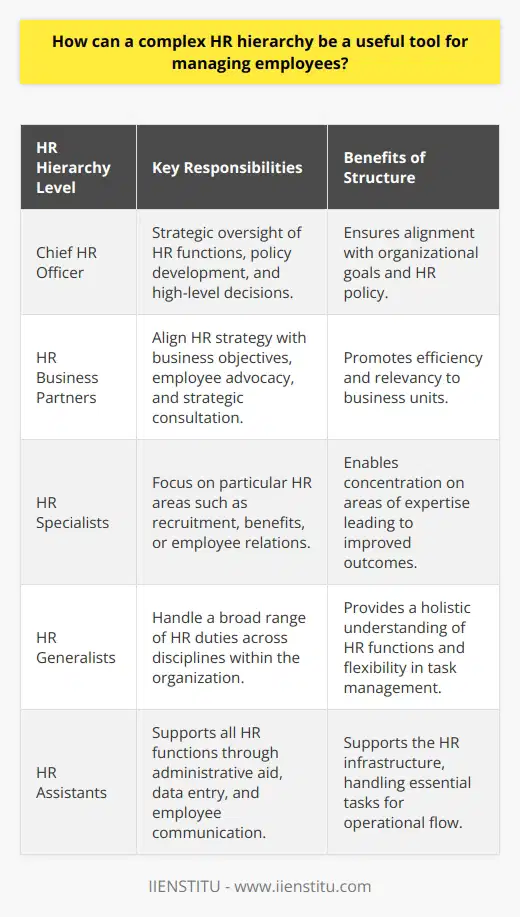
What factors influence the design of an HR department hierarchy?
Determinants of HR Department Hierarchy Design
Organizational Structure and Goals
The overall structure and strategic objectives of an organization play a crucial role in determining the design of an HR department hierarchy. A large, complex organization may require a more elaborate, multi-tiered HR department, whereas a smaller organization might function effectively with a flatter and more streamlined HR structure.
Company Culture and Values
The culture and values prevalent within a company significantly influence the design of the HR hierarchy. A company that promotes a participative and inclusive culture would have a more decentralized and accessible HR department, empowering individuals to take responsibility for their human resources functions. On the other hand, a hierarchical company culture would require a more centralized, top-down approach to human resources management.
Industry and Competitive Landscape
HR department hierarchy can also be influenced by the industry in which an organization operates and the competitiveness of the market. Industries with high employee turnover, a rapid business cycle, or significant regulatory requirements may necessitate a more specialized, structured HR department to efficiently manage workforce dynamics and external compliance pressures.
Technological Capacity and Expertise
The extent to which an organization has automated and integrated its HR systems and processes can affect the design of the HR department hierarchy. Technologically advanced organizations can employ leaner HR structures, as they capitalize on digital tools, data analytics, and artificial intelligence to streamline their HR operations. Conversely, organizations with limited technological capacity would need larger, more hands-on HR teams to manage manual processes effectively.
Talent Management Strategy
An organization's approach to talent management would also impact the design of its HR department hierarchy. Organizations that place a high emphasis on talent development, retention, and performance management may require more specialized teams within HR, focusing on specific areas such as training, employee engagement, and performance measurement. On the other hand, organizations with a more transactional approach to human resources might simply require a generalist HR team to handle core employee services.
In conclusion, the design of an HR department hierarchy is influenced by various factors, including organizational structure and goals, company culture and values, industry and competitive landscape, technological capacity and expertise, and talent management strategy. It is essential for organizations to consider these factors to ensure that their HR department hierarchy is optimally designed to support the business objectives effectively and efficiently.
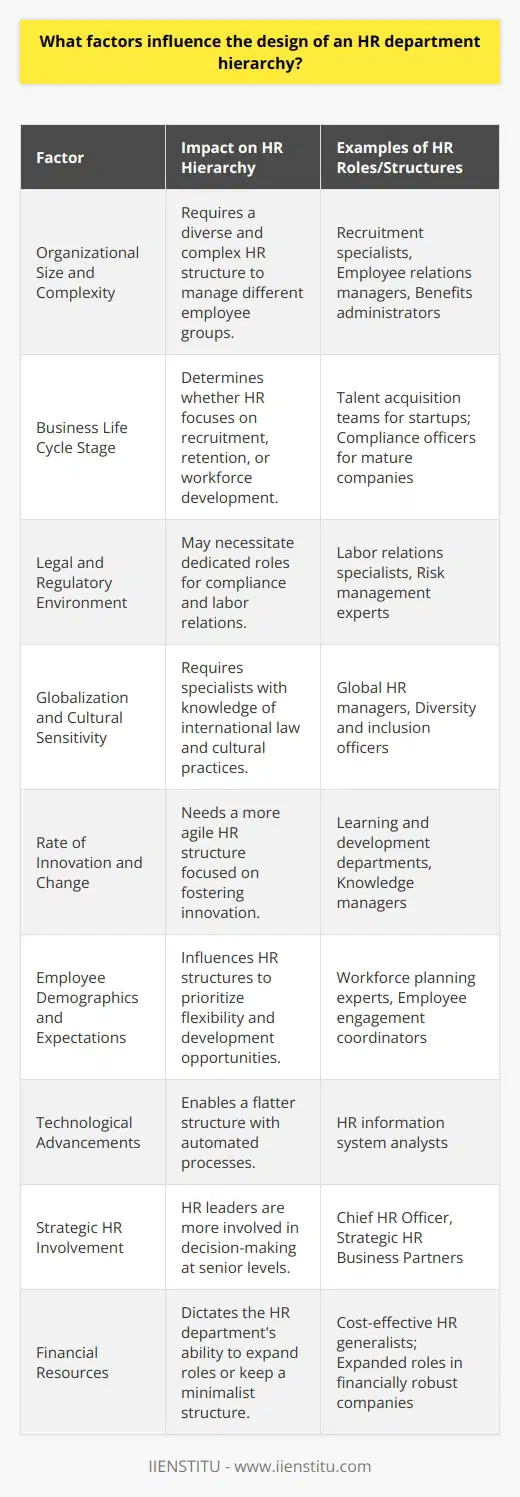
How do different levels of HR hierarchy contribute to the overall effectiveness of the department?
HR Hierarchy and Departmental Effectiveness
Understanding the HR Hierarchy
The Human Resources (HR) department consists of various levels of hierarchy, each contributing to the overall effectiveness of the department. The hierarchy typically involves entry-level positions, specialists, managers, directors, and HR executives. These different levels within the HR department ensure a wide range of roles and responsibilities, enabling the company to achieve its strategic goals and maintain a positive work environment.
Roles of Entry-Level Positions
The entry-level positions within the HR department, such as HR assistants and HR coordinators, perform essential administrative tasks. They contribute to the department's effectiveness by maintaining employee records, assisting with onboarding new hires, and providing support to HR specialists and managers. Their efficiency in data management and attention to detail is crucial for smooth HR operations.
Significance of HR Specialists
HR specialists focus on specific areas of human resources such as recruitment, training and development, compensation and benefits, or labor relations. Their expertise in their respective domains ensures that the company attracts and retains the right talent, provides adequate training for employee growth, and complies with applicable laws and regulations. Their contribution enhances the department's capacity to respond to the company's diverse needs.
Importance of HR Managers
HR managers supervise the overall functioning of their teams and ensure that HR policies and procedures align with the company's strategic objectives. Their leadership skills and decision-making abilities play a critical role in creating a positive work environment and addressing issues such as employee relations, performance management, and succession planning. They direct the department towards achieving its goals and fostering employee satisfaction.
Role of HR Directors and HR Executives
At the top of the HR hierarchy, HR directors and executives hold strategic responsibilities in shaping the organization's HR policies and objectives. Their experience and vision help to anticipate future trends and challenges, ensuring that the company remains competitive in an ever-changing business environment. They collaborate with other organizational leaders to maintain a culture that supports employee engagement, innovation, and diversity.
Conclusion
Each level of the HR hierarchy plays a vital role in the department's overall effectiveness. From entry-level positions carrying out essential administrative tasks to top executives setting strategic goals, every individual contributes to achieving a high-performing and satisfied workforce. By understanding the significance of each role within the hierarchy, organizations can better appreciate the value of a well-functioning HR department and its impact on the company's success.
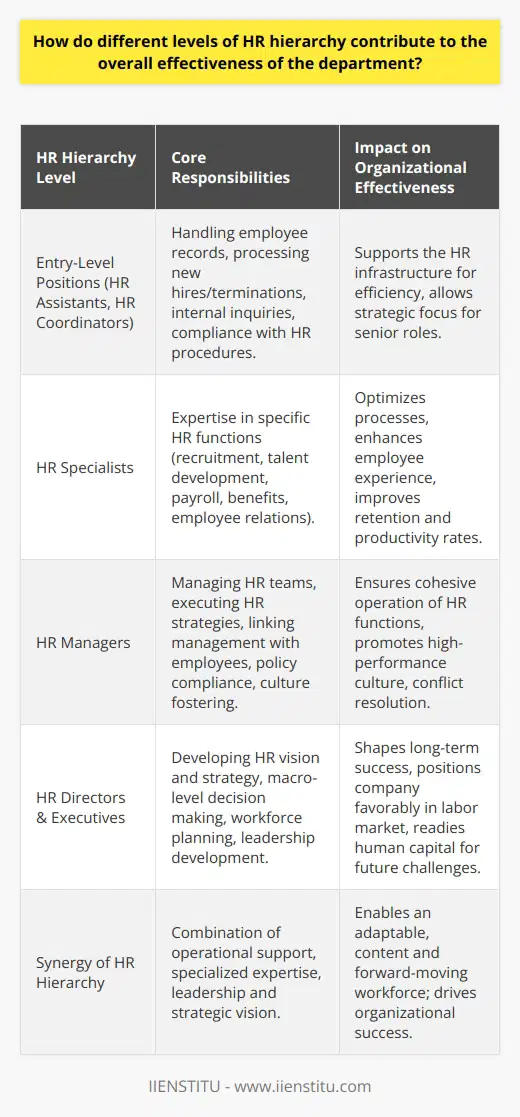
In what ways does the HR department hierarchy impact the implementation of HR policies and practices?
HR Department Hierarchy
The hierarchical structure of an HR department plays a significant role in the development and execution of HR policies and practices. The top-down establishment of authority and responsibility directly impacts the efficiency, communication, and overall organizational success of human resource management.
Role of HR Leaders
At the highest level, HR executives have the responsibility to develop strategic HR plans and oversee their implementation. They must ensure that policies and practices align with organizational objectives and comply with legal requirements. Their leadership influences the HR team's ability to drive change, encourage innovation, and cultivate a positive work environment.
Influence of HR Managers
HR managers hold a vital role in the implementation of HR policies and practices within their specific business units or departments. They are responsible for communicating policies to employees, providing necessary training, ensuring compliance, and addressing concerns. The effectiveness of HR managers in performing these tasks directly impacts the overall efficiency of policy implementation.
Significance of HR Specialists
HR specialists, such as recruiters, trainers, and benefits administrators, play a crucial role in the execution of HR policies and practices. Their expertise in specific HR functions helps ensure that the organization's human capital is managed effectively. The level of specialization and skill among these professionals affects the quality of HR services delivered to employees.
Interdepartmental Collaboration
Cooperation between HR leaders, managers, and specialists is essential for the successful implementation of HR policies and practices. Effective communication and collaboration prevent inconsistent application and interpretation of policies, promoting a harmonious and productive work environment. In addition, interdepartmental collaboration fosters innovation and continuous improvement of HR processes.
Conclusion
In essence, the HR department hierarchy greatly impacts the implementation of HR policies and practices. The effectiveness of HR leaders, managers, and specialists, along with their ability to collaborate effectively, directly influences the overall success of human resource management in an organization.

What is the relationship between HR complexity and employee satisfaction and performance?
The Relationship Between HR Complexity and Employee Satisfaction
In the organizational context, human resource (HR) complexity refers to the intricacy of HR policies, practices, procedures, and workforce diversity. Understanding the impact of HR complexity on employee satisfaction and performance has become critical for businesses seeking to maintain a competitive advantage.
Employee Satisfaction and HR Complexity
HR complexity can affect employee satisfaction both positively and negatively. On one hand, a diverse workforce and well-structured HR policies can result in improved interpersonal relationships, employee motivation, and workplace integration. On the other hand, excessive bureaucratic procedures and complicated policies may lower employee morale and create barriers to communication, leading to decreased satisfaction.
The Balancing Act of HR Complexity
It is essential for organizations to strike a balance between maintaining diverse and inclusive HR practices while minimizing unnecessary bureaucracy. Effective HR management focuses on reducing complexities in procedural matters, and enhancing the cultural elements that support work fulfillment and satisfaction.
Impact on Employee Performance
Employee performance is directly influenced by their job satisfaction level. Satisfied employees tend to show higher levels of job commitment, productivity, and performance. Embracing HR complexity while simplifying procedures can help create a work environment in which employees feel empowered, motivated, and committed to their organization's goals.
Strategies to Optimize HR Complexity
Organizations should assess and modify their HR practices to optimize their relationship with employee satisfaction and performance. This can be achieved through:
Streamlining HR policies: Reducing bureaucratic barriers and simplifying rules and procedures helps employees better engage with HR processes, leading to increased satisfaction and performance.
Embracing workforce diversity: Encouraging diversity in recruitment and promoting inclusive work cultures enhance employees' sense of belonging and commitment, positively affecting overall job satisfaction.
Fostering effective communication: Open channels of communication across an organization contribute to a clear understanding of the strategic objectives, which can positively impact employee morale and performance.
Offering professional development opportunities: By investing in employee training and skill development, organizations can increase job satisfaction and improve overall performance.
In conclusion, the relationship between HR complexity and employee satisfaction and performance is multifaceted. By understanding and managing HR complexities effectively, organizations can foster a workplace environment that is conducive to high levels of employee commitment, satisfaction, and performance.

How can organizations address HR complexity to streamline management and decision-making processes?
Identifying HR Challenges and Solutions
Organizations must first identify the specific challenges within their human resources (HR) departments to effectively address complexity and improve decision-making processes. By conducting audits, periodic evaluations, and using employee feedback, companies can recognize key areas that require streamlining and optimization. Through this identification process, targeted solutions can be developed and implemented, ensuring a more efficient management structure.
Implementing HR Technology
The incorporation of HR technology, such as human resources information systems (HRIS) and talent management software, can alleviate difficulties in managing employee data and tracking performance. These systems enable organizations to centralize and automate many HR tasks, thereby improving efficiency, reducing errors, and facilitating better data-driven decisions. By leveraging technology to manage increasingly complex HR operations, organizations can free up time and resources to focus on more strategic initiatives, such as talent development and employee engagement.
Enhancing Communication Channels
Establishing clear, consistent communication channels and protocols within an organization is essential to address HR complexity. This includes the use of effective communication tools like intranets, employee portals, or messaging systems, which can streamline information sharing and collaboration within departments and between employees. By promoting open channels of communication, organizations can make quicker, more informed decisions and ultimately create a more agile, responsive workplace.
Developing Standardized Processes
Introducing standardized processes for common HR tasks (e.g., hiring, onboarding, performance appraisals) can provide a consistent framework for decision-making and minimize organizational ambiguity. Having clear policies and guidelines in place not only increases efficiency within the HR department, but also reduces potential legal or compliance issues. By creating standard operating procedures, organizations can facilitate the decision-making process and promote fair treatment for all employees.
Enhancing Skills and Expertise
Investing in the ongoing professional development of HR personnel and other decision-makers within an organization is an essential aspect of streamlining management processes. Providing relevant education, training, and certifications enables employees to acquire the knowledge and skills necessary to make informed decisions, navigate complex HR issues, and proactively identify areas for improvement. Through continuous learning and professional growth, organizations can ensure they are equipped with the expertise needed to handle the challenges of HR complexity.

What role does technology play in managing and reducing HR complexity within an organization?
Role of Technology in HR Management
Enhancing Communication and Collaboration
Technology plays a significant role in improving communication and collaboration within an organization. It enables employees to share vital information seamlessly through instant messaging, collaboration platforms, and video conferencing tools. Moreover, these technologies enhance teamwork and facilitate decision-making, leading to better HR management and reduced complexity.
Automation of HR Processes
The automation of HR processes, such as recruitment, onboarding, payroll, and benefits administration, has been crucial in reducing HR complexity. By using human resource management systems (HRMS) and other digital tools, organizations can streamline their processes, reduce paperwork, eliminate manual data entry, and increase efficiency. Consequently, HR professionals can focus on more strategic tasks, enhancing overall organizational performance.
Data-Driven Decision Making
Technology enables the collection, analysis, and management of vast amounts of employee data, facilitating data-driven decision-making within organizations. HR analytics software significantly contributes to identifying patterns and trends, predicting workforce needs, and developing effective talent acquisition strategies. Furthermore, these insights support informed decision-making, leading to targeted talent development programs, higher employee retention, and optimization of personnel resources.
E-Learning and Development
Technological advancements have transformed the way employees learn and develop their skills. E-learning platforms allow organizations to offer personalized learning experiences, enabling employees to access the most suitable training materials for their needs. Interactive learning modules, simulations, and adaptive learning technologies promote continuous skill development, which helps reduce HR complexity by addressing skill gaps and enhancing workforce competence.
Remote Work Management
The rise of remote work has introduced new challenges in HR management, and technology plays a pivotal role in addressing these challenges. Tools for time tracking, project management, and performance monitoring allow organizations to effectively manage remote teams. By utilizing technology, HR departments can maintain cohesive work environments and ensure productive collaboration, ultimately reducing HR complexity within the organization.
In conclusion, technology is a driving force in managing and reducing HR complexity within organizations. It enhances communication and collaboration, automates HR processes, facilitates data-driven decision-making, promotes employee development, and supports remote work management. By leveraging these technological advancements, organizations can streamline their HR functions and maximize overall organizational performance.
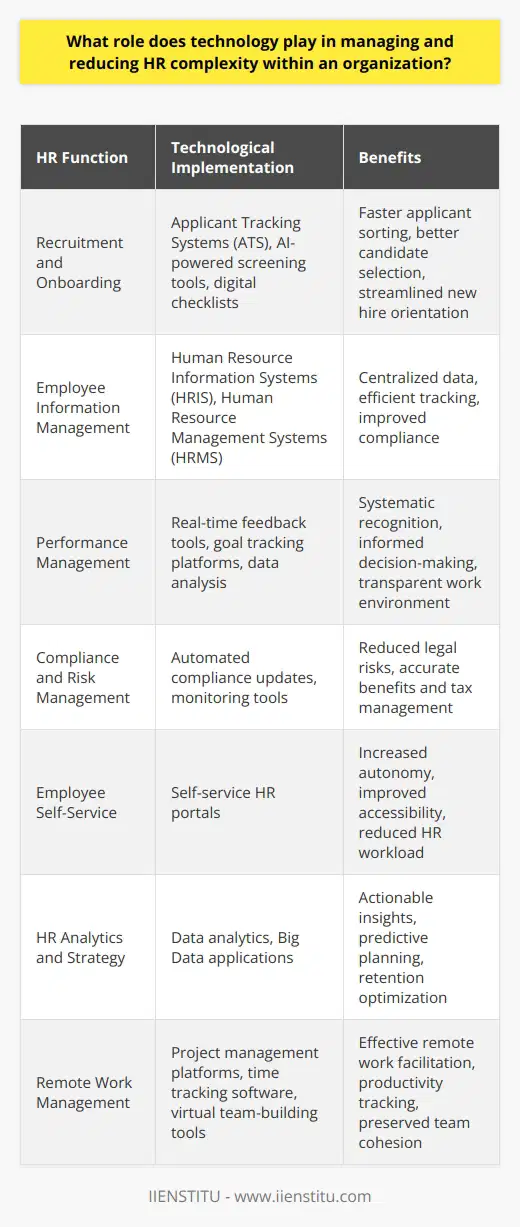
What are the primary factors contributing to HR complexity in organizations?
Factors Affecting HR Complexity
Organizational Structure
One primary factor contributing to HR complexity is the organizational structure of an organization. The hierarchy, division of labor, and communication channels within a firm can create challenges for HR managers. For instance, larger organizations with multiple departments and layers of management usually have more complicated human resource initiatives than smaller companies. As a result, HR personnel must navigate intricate reporting relationships, job roles, and the interaction between employees and management.
Workforce Diversity
Another significant factor is the diversity in an organization's workforce. As businesses expand globally and employ individuals from various socio-economic, cultural, and educational backgrounds, HR professionals must be adept at managing diverse teams. This complexity arises from differences in communication styles, work expectations, and values, which could result in conflicts and misunderstandings among employees. Moreover, laws and regulations regarding workplace discrimination and inclusion must also be upheld to maintain a healthy organizational culture.
Technological Advancements
Technological advancements inevitably contribute to the complexity of HR management as well. The use of various software tools for employee management, record-keeping, and communication can increase the efficiency and effectiveness of HR processes. However, the adoption of these technologies also necessitates effective training, data management, and cybersecurity measures, which in turn creates complexity within the HR function. Additionally, the rapid pace of technological developments impacts job requirements, necessitating continuous training and development of employees.
Legal and Regulatory Compliance
HR complexity is further heightened by the need to comply with numerous legal and regulatory obligations. HR professionals must ensure that their organizations adhere to employment laws, healthcare regulations, and workplace safety standards. Non-compliance with these requirements can result in hefty fines, lawsuits, and damage to the organization's reputation. To minimize legal risks, HR managers must be knowledgeable about local, national, and international regulations governing employee relations and business operations.
Organizational Culture and Change Management
Lastly, the unique organizational culture and change management processes contribute to HR complexity. HR professionals play a crucial role in shaping the company culture, promoting a positive work environment, and managing resistance to change. This responsibility entails understanding employees' attitudes and behaviors, developing effective communication strategies, and designing employee engagement initiatives. Furthermore, the fluidity of business environments requires HR managers to be proactive in embracing organizational changes and facilitating the adaptation process for employees.
In conclusion, the complexity of HR management within organizations primarily stems from factors such as organizational structure, workforce diversity, technological advancements, legal and regulatory compliance, and organizational culture and change management. Addressing these challenges necessitates expertise, adaptability, and effective communication strategies from HR professionals.

How do cultural and contextual differences impact the complexity of managing human resources in multinational companies?
Cultural Diversity in the Workplace
One of the major challenges multinational companies face is effectively managing human resources amidst the cultural and contextual differences that come with operating in different countries. These differences can impact communication, organizational structures, and decision-making processes. To address these challenges, companies must develop strategies that take into consideration diverse cultural values, attitudes, and perspectives.
Effective Cross-cultural Communication
Misunderstandings and misinterpretations often occur in multicultural work environments due to language barriers and different communication styles. Companies need to invest in language training and cultural awareness programs to improve communication among employees and foster a collaborative atmosphere.
Flexible Organizational Structures
Multinational corporations may need to adapt their organizational structures to accommodate the cultural norms and expectations of their local workforce. By understanding and respecting the host country's social norms, companies can create a work environment that is more culturally responsive and better suited to employees' preferences.
Tailoring HR Policies and Practices
Global companies must tailor their human resource policies and practices according to the local regulatory environment and cultural norms. This may involve customizing compensation and benefits packages, recruitment processes, and performance management systems to better fit the local context.
Encouraging Inclusion and Diversity
Promoting an inclusive work environment that respects and values the unique contributions of all employees is essential in managing cultural differences. By fostering multiculturalism through diversity and inclusion initiatives, companies can harness the distinctive characteristics of their workforce and capitalize on their collective strengths.
Conclusion
In conclusion, cultural and contextual differences can pose significant challenges for multinational companies. To effectively manage human resources in a global context, companies need to adapt their communication strategies, organizational structures, and HR policies to fit local contexts. Additionally, promoting inclusion and diversity is a crucial step towards leveraging the benefits of a multicultural workforce.

In what ways can effective HR leadership mitigate the challenges associated with the complexity of human resource management?
Understanding the Complexity of Human Resource Management
Human resource management (HRM) is becoming increasingly complex due to various factors, such as globalization, diversity, and technological advancements. Effective HR leadership plays a crucial role in addressing these challenges and ensuring a smooth functioning of the organization.
Developing Strategic HR Vision
One way to mitigate HRM challenges is by developing a strategic HR vision. This involves aligning HR policies and practices with the organization's overall goals and objectives, ensuring that employees are engaged and motivated, and creating an environment conducive to productivity and innovation.
Maintaining a Positive Organizational Culture
Another approach is to prioritize the cultivation of a positive organizational culture. This includes fostering a respectful and inclusive work environment, recognizing and rewarding employee achievements, and promoting a healthy work-life balance. Effective HR leaders can identify aspects of the organizational culture that can be improved, which will contribute to employee satisfaction and ultimately to better organizational outcomes.
Embracing Diversity and Inclusion
Embracing diversity and inclusion is another critical aspect of effective HR leadership. This entails creating policies and practices that promote equal opportunities for all employees, irrespective of their background, skills, or experiences. Inclusive HR policies not only ensure that employees feel valued but also help in attracting and retaining a diverse workforce, which can enhance innovation and creativity within an organization.
Leveraging Technological Advancements
Lastly, leveraging technological advancements can significantly improve HR processes and reduce the complexity associated with HRM. Implementing digital tools and technologies, such as HR software, analytics, and artificial intelligence, can streamline HR functions, automate repetitive tasks, and facilitate better decision-making. By embracing technology, HR leaders can be more proactive and data-driven, leading to improved efficiency and effectiveness in managing human resources.
In conclusion, effective HR leadership is essential for addressing the challenges associated with the complexity of human resource management. By focusing on strategic HR vision, cultivating positive organizational culture, embracing diversity and inclusion, and leveraging technology, HR leaders can overcome these obstacles and drive organizational success.
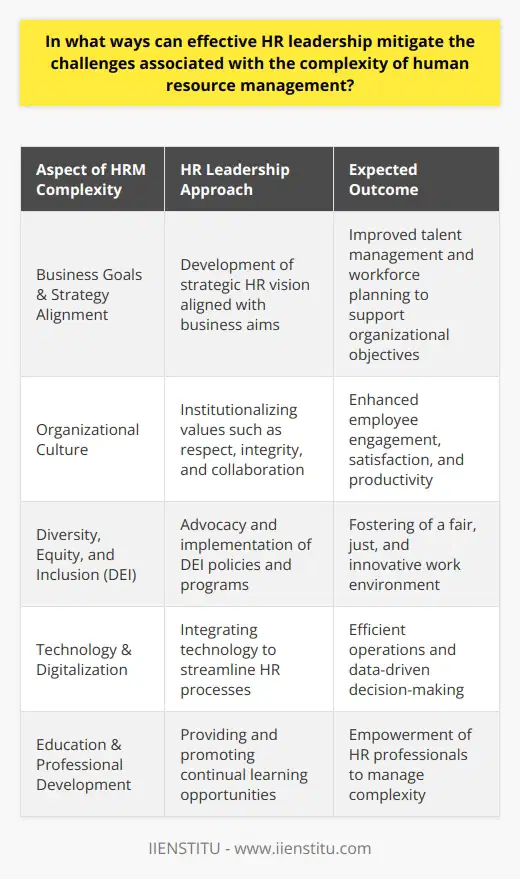
What is the role of organizational culture in contributing to HR complexity?
Role of Organizational Culture
Understanding Organizational Culture
The role of organizational culture in contributing to HR complexity cannot be overstated. In essence, an organization's culture serves as its unique fingerprint, influencing its values, norms, beliefs, and practices. As such, it plays a critical role in shaping the employee experience and, ultimately, determining an organization's success or failure.
Impact on Recruitment and Retention
A strong organizational culture can make recruiting top talent more effective and less complicated. A well-defined culture enables HR to identify and select candidates who align with the organization's values, ensuring a smoother onboarding process. Conversely, a weak or ambiguous culture may attract candidates with an inconsistent fit, exacerbating complexities in employee integration and retention.
Influence on Employee Engagement and Performance
Organizational culture also has a significant impact on employee engagement and performance. A positive and supportive culture fosters motivated and committed employees, leading to higher productivity, job satisfaction, and lower turnover. Conversely, a toxic or negative culture can contribute to disengaged employees, poor performance, and ultimately higher HR complexity in managing staff morale, performance improvement plans, and attrition.
Effect on Conflict Resolution and Decision-Making
Additionally, organizational culture shapes how conflicts are resolved and decisions are made within the company. A culture that promotes open communication, fairness, and collaboration facilitates quicker and more effective conflict resolution and decision-making. On the other hand, a culture that lacks these attributes can contribute to a complex and time-consuming process for HR when dealing with conflicts, grievances, and decision-making.
Implications for HR Strategy and Development
Understanding and effectively managing an organization's culture is essential for streamlining HR processes and reducing complexity. HR professionals need to be aware of the cultural implications of every decision they make, from recruitment and performance management to organizational development and change management. Addressing the role of culture in these processes can improve efficiencies and contribute to a more coherent and effective HR strategy.
In conclusion, organizational culture plays a central role in contributing to HR complexity. Managing and cultivating an organizational culture that aligns with the company's goals and values is critical for HR to effectively navigate and address the challenges posed by the ever-changing and complex business environment.

How do legal and regulatory environments impact the complexity of managing human resources in different countries?
Legal Frameworks and their Impact
Legal and regulatory environments significantly influence the complexity of managing human resources (HR) across various countries. The diversity of labor laws and regulations affects HR practitioners and multinational corporations' ability to establish uniform policies and practices. One critical aspect to consider includes employment rights and protection, which vary from one nation to another.
Variations in Employment Legislation
In developed countries, employment legislation tends to be comprehensive, thereby ensuring employees are protected from unfair workplace practices. However, in less developed countries, employment laws may be less stringent or poorly enforced, leading to disparities in working conditions. This may result in HR management teams having to invest additional resources in understanding and implementing policies in line with local regulations.
Cultural Diversity and HR Practices
Moreover, the underlying social norms and cultural values within different countries further complicate HR management. What may be considered acceptable or commonplace in one country may be viewed as discriminatory or unfair in another. For example, acceptable hiring preferences or employee benefits that cater to cultural or religious sensitivities must be aligned with local laws. As a result, HR professionals must possess an in-depth understanding of local cultural nuances to develop policies that can bridge these gaps successfully.
Data Protection and Privacy Concerns
In the face of increasing data protection and privacy regulations globally, HR managers need to navigate complex legal frameworks when handling employee data. Compliance with data protection laws, such as the European Union's General Data Protection Regulation (GDPR), is important to protect employee rights and avoid costly penalties. This requires HR professionals to be vigilant and up-to-date with the legislative changes and regulations impacting the management of employee data in different countries.
Adapting HR Strategies Across Borders
In conclusion, the diverse legal and regulatory landscape across countries adds significant complexity to managing human resources. HR professionals must adapt their strategies to comply with varying employment laws, cultural differences, and data protection regulations to maintain a fair work environment within multinational corporations. To achieve this, it is crucial for HR practitioners to possess a comprehensive understanding of local contexts and adopt a flexible approach to policy formulation and implementation.
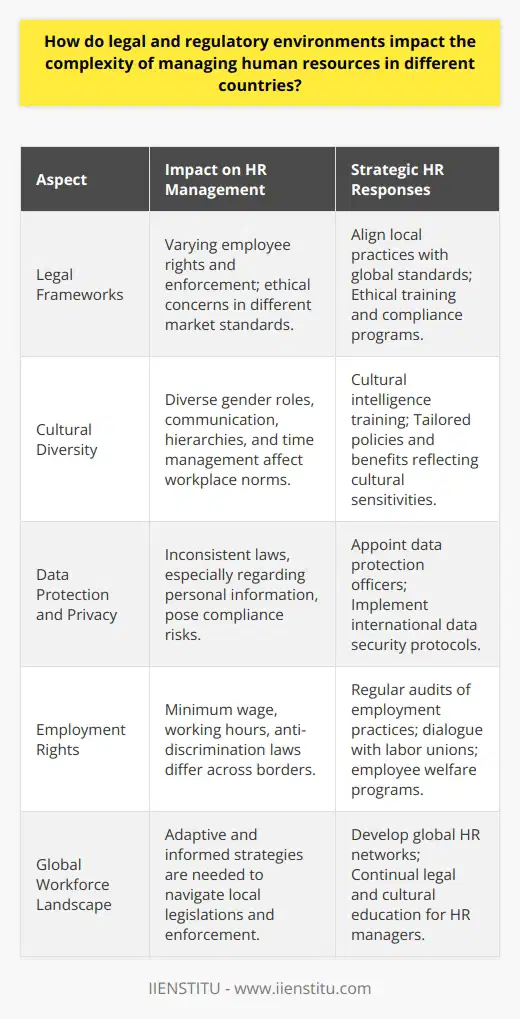
What strategies can be employed by HR managers to navigate the challenges posed by workforce diversity and varying employee expectations?
Strategies for Navigating Workforce Diversity
To effectively navigate the challenges posed by workforce diversity and varying employee expectations, HR managers can employ several strategies. First, they can promote inclusivity in the workplace by ensuring that all employees feel valued and respected irrespective of their differences. This involves fostering a culture of open communication, allowing employees to express their thoughts and concerns without the fear of being judged or marginalized.
Implementing Diversity Training
Educating employees on the importance of diversity and its impact on organizational performance is another effective strategy. By offering diversity training programs, HR managers can equip employees with the knowledge and skills needed to function effectively in a diverse workforce. Training should be aimed at helping employees overcome inherent biases, stereotypes, and prejudices that might hinder their interactions with colleagues from different backgrounds.
Creating Employee Resource Groups
Establishing employee resource groups (ERGs) can also help HR managers address the challenges of workforce diversity. ERGs are voluntary, employee-led groups that provide a platform for individuals with shared interests or backgrounds to connect and support each other. By encouraging the formation of ERGs, HR managers can create an environment where employees gain a sense of belonging, leading to increased job satisfaction and retention.
Flexible Work Arrangements
To address varying employee expectations, HR managers should consider offering flexible work arrangements. This could include options such as remote work, flexible hours, or job sharing. Such arrangements enable employees to manage their work and personal lives more effectively, ultimately leading to increased morale and productivity. HR managers should also regularly solicit feedback from employees, assessing the effectiveness of these arrangements and making adjustments as needed.
Tailored Career Development Opportunities
Finally, HR managers must understand that different employees have unique career aspirations and goals. They should create tailored career development opportunities that cater to the diverse needs and preferences of their employees. This may involve offering customized training programs, mentorship opportunities, or personalized performance evaluations. By doing so, HR managers can help employees reach their full potential and contribute more effectively to the organization's success.
In conclusion, HR managers can navigate the challenges posed by workforce diversity and varying employee expectations by promoting inclusivity, implementing diversity training, creating employee resource groups, offering flexible work arrangements, and providing tailored career development opportunities. These strategies can help create a more inclusive, engaged, and productive workplace that benefits both employees and the organization.

What is the role of HR analytics in addressing and managing HR complexity?
Role of HR Analytics in Managing Complexity
Understanding HR Complexity
Human Resource (HR) complexity arises from the intricate dynamics within organizations, including diversity in the workforce, variation in employee needs, and evolving business environments. To manage this complexity, HR departments must constantly adapt and innovate in their strategies and practices.
Significance of HR Analytics
HR analytics plays a crucial role in addressing and managing HR complexity by providing data-driven insights that facilitate informed decision-making. Through the systematic analysis of workforce data, HR professionals can gain a deeper understanding of the workforce's composition, performance, and trends, which in turn helps to improve overall organizational effectiveness.
Enhancing Decision-Making Processes
One of the key roles of HR analytics is its ability to support better decision-making processes within organizations. By leveraging quantitative and qualitative data, HR departments can identify patterns, determine key performance indicators (KPIs), and assess the impact of various HR initiatives. This information enables HR professionals to make evidence-based decisions, aligning HR strategies with organizational objectives and fostering a more agile approach in handling HR complexity.
Fostering Greater Personalization
Another essential aspect of HR analytics in managing complexity is its ability to support more personalized approaches to HR management. As the workforce becomes increasingly diverse, organizations need to adopt more tailored tactics to attract, engage, and retain top talent. HR analytics facilitates a deeper comprehension of employee preferences, motivations, and behaviors, empowering HR professionals to design and implement interventions that cater to individual employee needs, and ultimately improving staff satisfaction, retention, and productivity.
Predicting and Preempting Issues
Moreover, HR analytics also assists in predicting and preempting potential challenges that may surface within an organization's workforce. By providing HR departments with an understanding of employee trends, analytics can help identify emerging problems, such as skill gaps, talent shortages, or employee turnover risks. Consequently, HR professionals can proactively address these concerns by implementing targeted initiatives, preventing further complications and allowing organizations to navigate HR complexity more effectively.
Conclusion
In summary, HR analytics significantly contributes to addressing and managing HR complexity within organizations by offering valuable insights into the workforce and enabling evidence-based decision-making. Through its role in enhancing decision-making processes, fostering personalization, and predicting potential challenges, HR analytics serves as a vital tool for HR professionals as they navigate the complexities of modern human resource management.
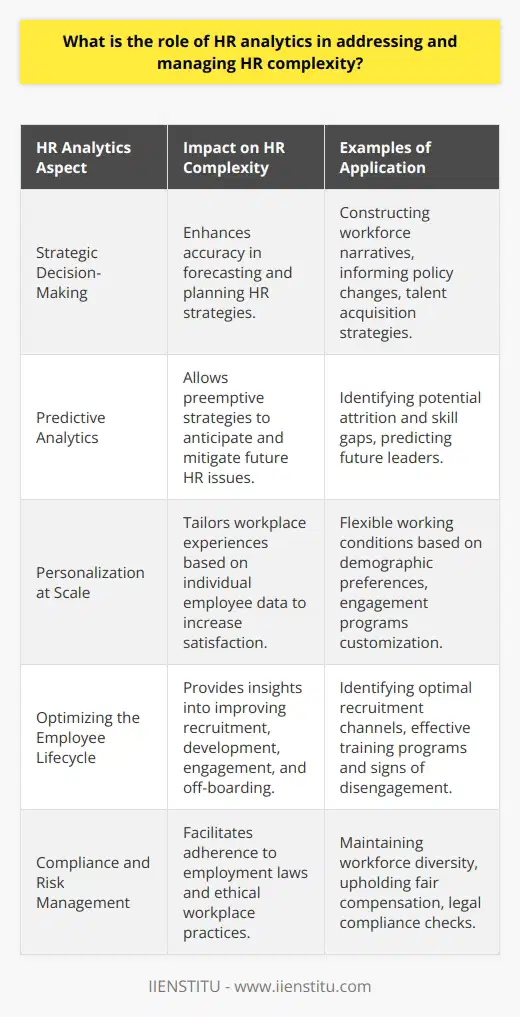
How do talent management strategies help in reducing the complexity of HR?
Role of Talent Management Strategies
Talent management strategies play a crucial role in minimizing the complexity in the human resources (HR) function. By identifying, developing, and retaining top-notch employees, these strategies help organizations to thrive and achieve their business objectives while reducing the burden on HR departments.
Streamlining Recruitment and Onboarding
A key aspect of talent management is streamlining the recruitment and onboarding processes. By leveraging appropriate tools and techniques, HR professionals can identify the right candidates, match them to suitable roles, and shorten the time taken to fill open positions. Consequently, this reduces the burden on HR resources and ensures that new employees can efficiently contribute to the organization's success.
Performance Management and Employee Engagement
Talent management strategies also focus on continuously assessing and enhancing employee performance, engagement, and retention. By implementing effective performance management practices, HR departments can identify areas for improvement, allocate resources, and provide targeted training and development interventions. This proactive approach helps to avert potential issues, such as high employee turnover, and strengthens employee commitment to the organization's goals.
Succession Planning and Leadership Development
Another crucial aspect of talent management is succession planning and leadership development, which entail anticipating future needs and grooming employees for leadership roles. By proactively identifying potential leaders, organizations can reduce the complexity associated with unplanned personnel changes and ensure a smooth transition between leadership teams. This, in turn, diminishes HR workload and enables a culture of growth and sustainability.
Enhancing Organizational Agility and Adaptability
Finally, effective talent management strategies foster organizational agility and adaptability. By nurturing a robust talent pipeline, organizations can rapidly shift resources, adapt to changing business requirements, and respond effectively to market competition. This flexibility not only reduces HR's complexity but also enhances overall organizational resilience and competitiveness.
In conclusion, talent management strategies significantly contribute to reducing the complexity of HR by streamlining essential processes, promoting employee engagement, facilitating succession planning, and fostering an agile organizational culture. By implementing these strategies, companies can focus their HR efforts on more strategic tasks, driving business success and sustainability.

How do organizational changes and restructuring impact the complexity of HR management?
Impact of Organizational Changes on HR Management Complexity
Organizational Structure Modifications
Organizational changes and restructuring significantly impact the complexity of human resource (HR) management. Alterations in organizational structure, such as mergers, acquisitions, and downsizing, present significant challenges for HR managers to navigate. These structural changes often require HR professionals to develop new policies and procedures, realign job roles and functions, and oversee the integration of employees from different organizational cultures and backgrounds.
Talent Acquisition and Retention
Implementing organizational changes can directly affect talent acquisition and retention, as HR managers must contend with hiring, onboarding, and training new employees while simultaneously fostering satisfaction and commitment among existing staff. Organizational restructuring often incites uncertainty among employees, which can consequently impact employee morale, job satisfaction, and turnover rates. HR managers must develop comprehensive strategies to attract, retain, and nurture top talent while addressing employee concerns throughout the restructuring process.
Workforce Planning and Development
Organizational changes also necessitate shifts in workforce planning and development, as HR managers must forecast future labor requirements, identify skill gaps, and invest in employee training and development initiatives to meet new organizational demands. Consequently, introducing new organizational structures and technologies often calls for HR professionals to reassess workforce capabilities and develop targeted skills development programs to enhance employee productivity and adaptability during times of organizational change.
Performance Management and Evaluation
Restructuring efforts can significantly influence performance management systems and evaluation processes within an organization. HR managers must not only revamp performance management tools and criteria to align with new organizational objectives but also ensure that employees understand these changes and are informed about the anticipated impacts on employee evaluations and rewards. This highlights the importance of transparent communication between HR managers and employees throughout the entire restructuring process to mitigate potential confusion and resistance.
Employee Relations and Communication
Effective employee relations and communication strategies are essential during organizational changes to minimize detrimental impacts on employee productivity and satisfaction. HR managers must proactively engage with employees, address their concerns, and promote a sense of inclusion and understanding. This requires HR professionals to be attuned to the emotional and psychological dimensions of change and adept at fostering a culture of open dialogue and trust within the organization.
In conclusion, organizational changes and restructuring introduce numerous complexities for HR management, ranging from changes in talent acquisition and workforce planning to adjustments in performance management and employee relations. To successfully navigate these complexities, HR managers must develop comprehensive strategies that prioritize employee engagement, satisfaction, and adaptation to embrace the new organizational environment.
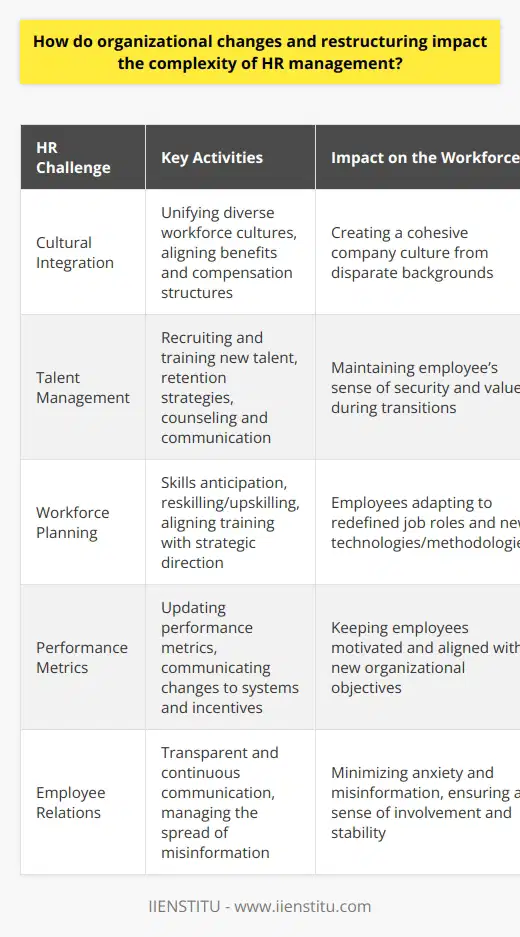
What is HR complexity and how does it influence the overall functioning of an organization?
Understanding HR Complexity
Human Resources (HR) complexity refers to the diverse challenges and problems that arise within the HR function of an organization. It includes the wide range of tasks, policies, procedures, and systems involved in managing a company's workforce. This complexity arises from various aspects including workforce diversity, legal mandates, technological advancements, and organisational changes.
HR Complexity and Organizational Functioning
HR complexity significantly influences the overall functioning of an organisation. For instance, labour laws and diverse workforce require a complex array of HR policies and procedures that can affect productivity and efficiency. HR complexity can create challenges in terms of manpower planning, recruitment, training, and performance management.
Tackling HR Complexity
Despite its challenges, organisations can leverage HR complexity to their advantage. By investing in training for HR professionals and incorporating effective HR technologies, organisations can manage HR complexities efficiently. An efficient and competent HR department can contribute toward better organisational outcomes by aligning human resources with organisational goals.
The Role of HR Technology
HR technology can streamline complex HR processes, facilitate compliance, and foster transparent communication. It can mitigate the impact of HR complexity by automating repetitive tasks, freeing up time for more strategic HR initiatives.
In conclusion, while HR complexity presents obstacles, effective management can turn these challenges into opportunities for organisational growth. By understanding the nature of HR complexity and its role within an organization, leaders can ensure that their HR functions contribute effectively to the achievement of business strategies. Moreover, adopting innovative HR technologies can further aid in managing the complex nature of HR tasks, thereby enhancing the overall efficiency and productivity of the organisation.
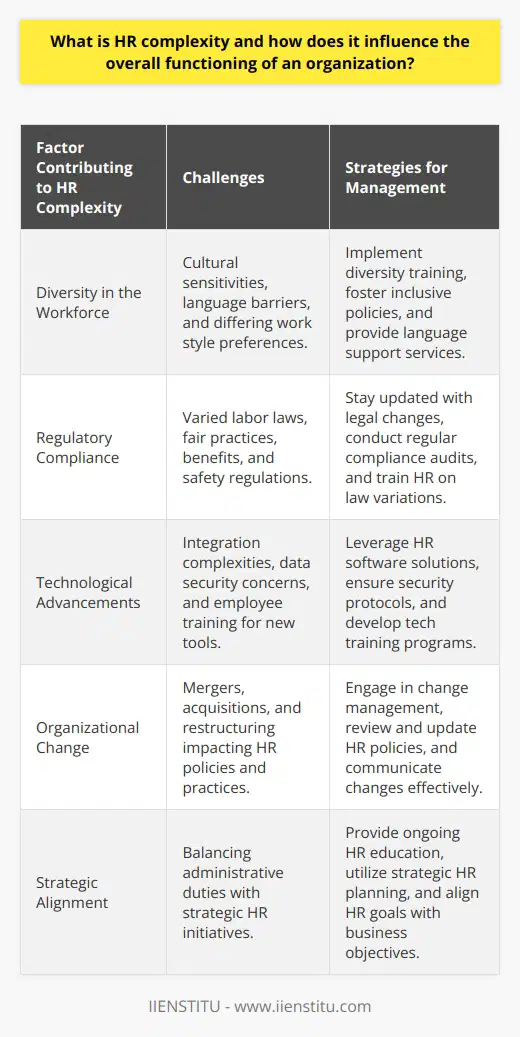
How does the hierarchy of an HR department affect the distribution of roles and responsibilities, and what are the potential challenges associated with it?
HR Department Hierarchy and Role Distribution
The hierarchy within an HR department greatly influences how it distributes roles and responsibilities. Typically, the head or director of HR delegates duties to mid-level and entry-level HR personnel, following a top-down style. Such hierarchical structures ensure that managers can supervise the tasks and performance of their subordinates and thereby maintain overall control.
Challenges in Hierarchical HR Structure
However, this hierarchical structure can often lead to communication gaps. Information tends to get diluted as it moves down the hierarchy. As a result, the message that reaches the lower-level employees can differ greatly from the original.
Lack of Initiative
Another major challenge related to HR hierarchy is the discouragement of initiative. Lower-level employees often wait for orders from superiors instead of taking autonomous action. This inertia could slow down the functioning of the HR department and hinder overall organizational agility.
Rigid Structures and Morale
More rigid hierarchical structures may create a sense of disempowerment among lower-level HR personnel. They could feel their ideas are overlooked due to their place in the hierarchy. This sense of low recognition may result in decreased morale and underperformance.
Balancing Hierarchy and Flexibility
Balancing the hierarchical structure with flexibility is critical to overcome these challenges. Providing room for lower-level employees to voice out their opinions could bridge communication gaps and foster innovative thinking. Furthermore, promoting a culture that values initiative and independence can enhance the efficiency and productivity of the HR department.
In conclusion, the hierarchy of an HR department plays a significant role in distributing tasks and responsibilities. However, it can also lead to potential challenges such as communication gaps, a lack of initiative, low morale, and sluggish performance. To counter these problems, fostering a level of flexibility within the hierarchical structure is crucial.
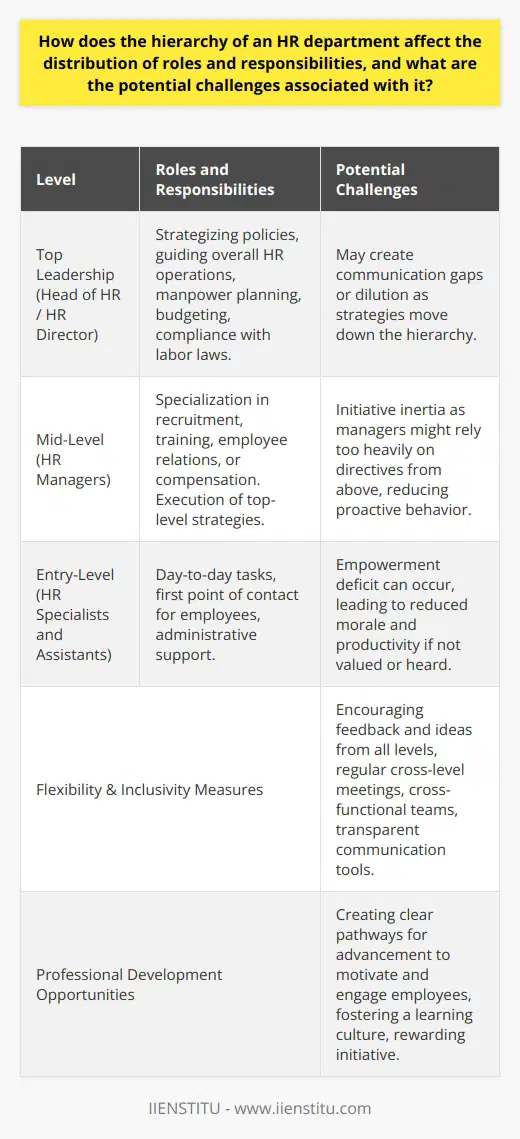
Why is the human resource management process considered to be complex, and what are the key factors contributing to this complexity?
Human Resource Complexity
Human resource management (HRM) is a complicated process due to various elements. Firstly, the diverse and dynamic human factor plays a significant role in this complexity. Each employee brings unique skills, personalities, and expectations, making it a challenging task to maintain a balance.
Individual Differences
HRM has to address the individual differences and ensure they work towards the company's objectives. This prompts the need for careful selection, training, and performance appraisal mechanisms, adding to the complexity.
Organizational Goals and Legal Requirements
HRM also needs to align individual goals with organizational objectives. This requires intricate strategies and constant adjustments. Moreover, legal and regulatory considerations add another layer of complexity. Ensuring compliance with labor laws, equality legislation, and health and safety norms necessitates thorough understanding and meticulous efforts.
Ethical Considerations
Ethical considerations also enhance HRM complexity. Upholding ethical values while fulfilling all organizational goals can be challenging. It involves dealing with dilemmas and making tough decisions.
Global Workforce Management
Management of a global workforce, with cultural, linguistic, and geographical differences, is another factor of complexity. It demands a deep understanding of cultural nuances, adaptation, and flexibility from the HRM.
Conclusion
In conclusion, managing human resources is complex due to the inherent diversity, ever-evolving regulatory environment, ethical challenges, and the pressure of aligning individual and organizational goals. Well-constructed and adaptable HR processes are vital to handle this complexity effectively and ensure the organization's success.
